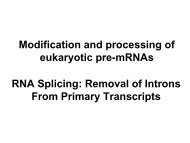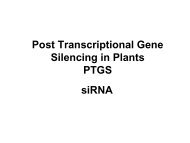You also want an ePaper? Increase the reach of your titles
YUMPU automatically turns print PDFs into web optimized ePapers that Google loves.
prp45-113 mutant, which is compatible with a defect in the transition from initiation to elongation of transcription. Wepreviously reported a genetic interaction between prp45-113 and the IOC2 and IOC4 genes that encode components of theISW1 chromatin remodeling complex. We have now also demonstrated interaction of Prp45p with Ioc4p in a pull-downassay.216 Establish splicing factor ChIP in MCF7 cell lines.The Neugebauer lab established stable MCF7 cell lines, harboring BACs with GFP-tagged U2AF65 and CBP80 forphysiological expression. [The paper establishing splicing factor ChIP in combination with the BAC technology is in press atMolecular Cell and acknowledges <strong>EURASNET</strong>.] Using these cell lines, the Aubeouf lab has employed the ChIP method andobtained very promising preliminary data on the Cyclin D1 gene. Production of additional tagged lines is in progress.217 Intronic siRNAs and alternative splicing.Small interfering RNAs (siRNAs) are known to mediate post-transcriptional gene silencing (PTGS) by promotingdegradation of target mRNAs. When targeted at promoter regions, siRNAs participate in an alternative pathway known astranscriptional gene silencing (TGS) by promoting histone methylation, heterochromatin formation and inhibition oftranscription. We found that siRNAs targeting sequences located closer to an alternative exon are able to regulate itsalternative pre-mRNA splicing in mammalian cells. The effect needs both AGO-1 and AGO-2 and is abolished or reducedby factors that favor an open chromatin structure or increase transcriptional elongation. The mechanism involves theformation of facultative heterochromatin epigenetic marks (H3K9me2 and H3K27me3) at the target site and thehetorochromatin associated protein HP1. These localized chromatin modifications disturb transcriptional elongation,therefore affecting the kinetic coupling between transcription and alternative splicing. A first revision of the manuscript isbeing prepared for NSMB.219 Co-transcriptional splicing of HIV nascent transcripts.To determine whether splicing of HIV nascent transcripts is co-transcriptional, using a model gene comprising a split MS2reporter. ChIP of the MS2 binding protein will indicate when and where along the gene splicing catalysis occurs. Theseexperiments are in progress, following transfer of splicing factor ChIP protocols from the Neugebauer lab. The Bertrand labhas generated a hybrid construct containing the first intron of the human β-globin gene inserted into an MS2 site. This splitMS2 site was cloned dowstream of the HIV-1 promoter, and stable clones of U2OS cells expressing this RNA were selected.Additionally, BACs encoding GFP-tagged splicing factors as well as stable cell lines already expressing those factors havebeen transferred from the Neugebauer lab to the Bertrand lab to facilitate further co-transcriptional assays. A feasibilitystudy is underway, in which BAC-transformed and HIV model gene-containing cell lines will be fused to produceheterokaryons and facilitate fluorescence microscopy studies.Problems and explanations for delays, postponements etc.218 PTB and co-transcriptional recruitment to target genes identified in the Smith lab.The original idea of this deliverable was to validate PTB targets in vivo, employing splicing factor ChIP to localize PTB onputative target genes. The Neugebauer lab worked very hard on this, recombineering both N- and C-terminally taggedversions of PTB on a variety of mouse and human BACs. The recombineering was always OK, but none of the taggedproteins were expressed when BACs were transfected. This has never happened before, but we have to conclude that the taginduces incorrect folding of PTB. Therefore, we pursued ChIP with antibodies specific for PTB, but these also failed (likelyreason is epitope inavailability). Therefore, the original approach has not proven to be feasible, but our new deliverable,using an MS2 sequence in the context of a model gene to target PTB regulation, allows us to address related biologicalquestions.56







